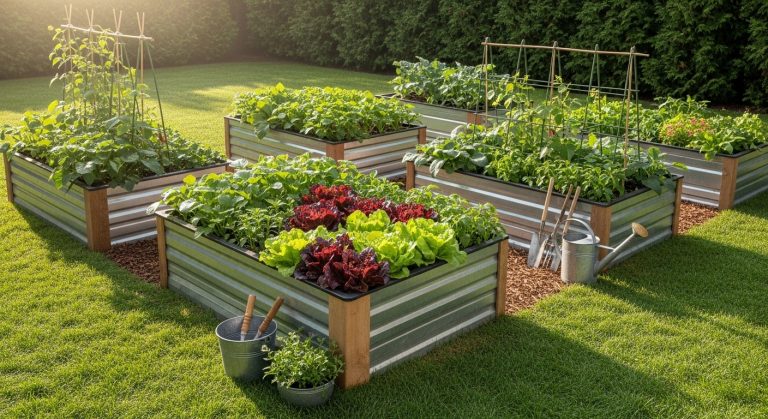15 Inspiring Rosemary Garden Ideas for Your Outdoor Space
I’ve always felt gardens are like personal stories—each plant a character with quirks, perks, and sometimes moods of its own. And rosemary? It’s one of those reliable characters that shows up in your story again and again, often in surprising ways. One day I noticed the rosemary hedge I’d planted didn’t just smell good—it framed my little reading nook, kept pests at bay, and even became a cue for visitors to linger longer.
Why focus on rosemary garden ideas right now? Because in a world full of flashy landscaping trends, perennial shrubs, and exotic blooms, rosemary offers something refreshingly simple: structure, scent, edible value, and a dash of rugged Mediterranean charm. According to one garden design guide, rosemary is drought-tolerant, pest-resistant, and thrives in containers or beds alike.
So let’s chat like two garden-nerd friends, wander through fifteen clever and varied ways to use rosemary in your landscape, and help your space reflect your style and your love for easy-going greenery. Ready? Let’s dig in.
1. Rosemary as a Fragrant Border Hedge

Imagine walking down a path lined by a low hedge whose foliage is softly silvery-green, its scent brushing the air — that’s rosemary as a border hedge.
Pros:
- Adds structure and form to a garden, clearly defining walkways or edges.
- Releases fragrance when brushed against — adds an immersive sensory layer to your space.
- According to Gardenia, rosemary works well as an evergreen framework in the garden.
Cons:
- Needs regular trimming or shaping if you want it to stay neat — otherwise it can become “wild bush” rather than “hedge”.
- If planted in heavy or poorly-draining soil, roots may suffer (rosemary hates “wet feet”).
Takeaway:
If you’re craving a mix of order and aroma in your landscaping, a rosemary hedge gives you both — just be ready for some light maintenance to keep it crisp.
2. Rosemary in Containers: Patio Hero

If your space is a balcony or a patio pot-garden, rosemary can be a showy, scent-filled star.
Pros:
- Thrives in pots if you provide fast-draining soil — ideal for patios.
- Offers easy access for snipping fresh herbs for the kitchen, turning your patio into a multi-sensory space.
Cons:
- Containers dry out more quickly; you’ll need to watch watering carefully.
- In colder climates you might need to bring it indoors or protect it in winter, adding an extra step.
Takeaway:
Limited space? No problem. A couple of rosemary pots give you fragrance, greenery, and function — perfect for patio-living.
3. Creeping Rosemary as Ground Cover

Here’s a twist: instead of upright, think low and spreading — let rosemary carpet an area.
Pros:
- Takes up low-level space beautifully, softening bare patches or slopes.
- Drought-tolerant and hardy — one article lists creeping rosemary as a top fragrant ground cover.
Cons:
- It may need space to spread, so if planted too densely, it can compete with neighbouring plants.
- If your climate or soil holds too much moisture, it may fail or rot — again, drainage matters.
Takeaway:
If you’ve got a slope or an awkward space that needs green love, creeping rosemary is an elegant and effusive solution.
4. Herb Spiral Design Featuring Rosemary
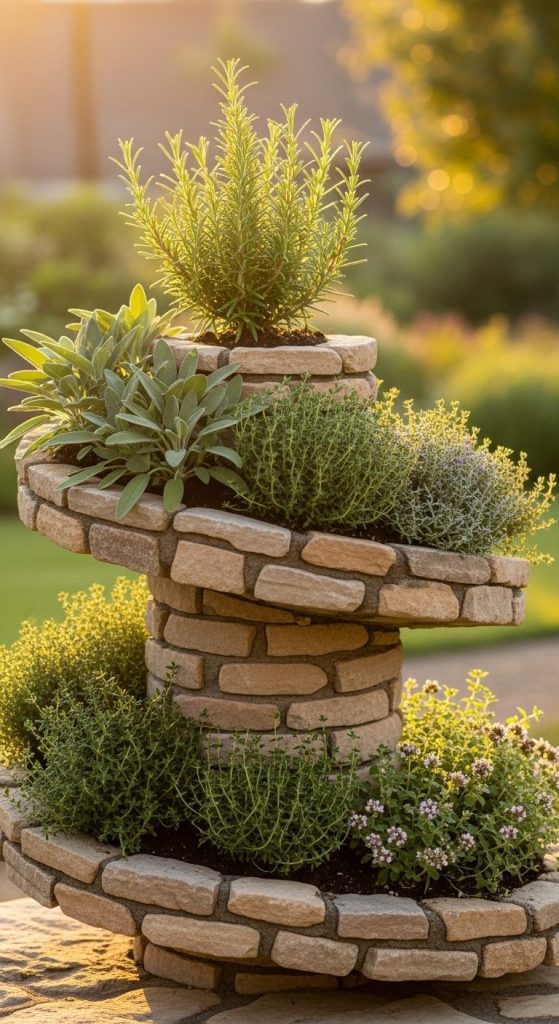
Ever heard of an herb spiral? A smart permaculture concept where plants with different needs spiral around a central height. Rosemary fits beautifully into this because it can go on the sunnier, drier side of the spiral.
Pros:
- Adds dynamic form and visual interest — the spiral shape is eye-catching.
- Mixes function (herbs) and form (garden structure) — rosemary alongside thyme, oregano, or sage gives texture and scent.
Cons:
- Building an herb spiral takes more initial work (elevation changes, ensuring drainage differences across the spiral).
- If you don’t position rosemary correctly (sun + well-drained soil) it may underperform.
Takeaway:
Want something a little adventurous in your garden design? An herb spiral with rosemary gives you beautiful form and utility.
5. Rosemary as a Backdrop for Flower Beds

Rather than stand alone, rosemary can anchor the rear of a flower bed, providing evergreen structure behind shrubs or perennials.
Pros:
- Its evergreen foliage keeps the bed from looking “empty” in dormant seasons.
- According to a garden article, tall upright varieties of rosemary make good middle-layer or background plants.
Cons:
- May compete for space or light if paired with plants that prefer shade or more moisture.
- Since rosemary has a strong scent, not everyone loves it all day long — consider placement relative to gathering areas.
Takeaway:
If you want a bed that looks good year-round, layer rosemary at the back for texture and scent while the bloomers get the limelight in front.
6. Rosemary Topiary or Sculptural Feature

Fancy something a bit more formal? Clip rosemary into shapes for a sculptural, bespoke garden element.
Pros:
- Unique and elegant — a rosemary sphere, spiralled stem or clipped hedge says “stylish gardener”.
- Keeps the scent and herb-benefit while elevating the aesthetic.
Cons:
- Requires regular pruning and shaping — needs a gardener-mindset.
- Over-pruning too late in the season can harm the plant (some sources caution about timing).
Takeaway:
If you enjoy the artistry of gardening and don’t mind the upkeep, a rosemary topiary is a classy statement piece.
7. Planting Rosemary Around a Seating Area

Picture a bench or a little garden nook surrounded by rosemary — you brush past it, inhale its scent, and your senses perk up.
Pros:
- Adds a sensory dimension to your relaxation spot (scent + texture).
- Easy to harvest a few sprigs while you’re sitting; it’s functional and beautiful.
Cons:
- You’ll want to keep rosemary trimmed so it doesn’t encroach on the seating space.
- If your seating area is shaded and rosemary thrives in full sun, you might need to rethink or relocate.
Takeaway:
Create a “sit-and-smell” corner — rosemary around your seat adds atmosphere and utility in one.
8. Companion Planting with Rosemary for Pest Control
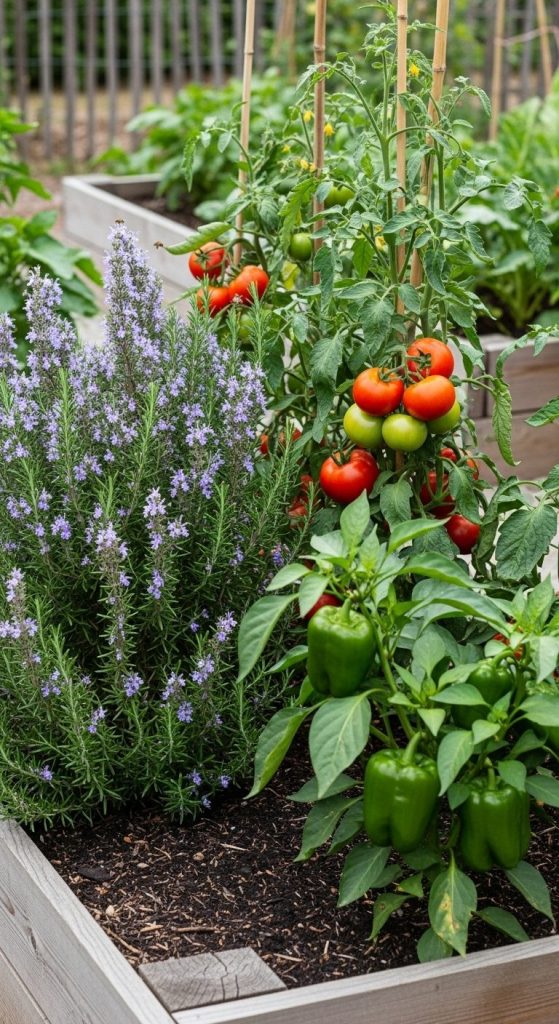
Here’s a smart one: sprinkle rosemary among vegetables or vulnerable plants to repel pests naturally. According to Gardenia, rosemary repels multiple pests and attracts beneficial pollinators.
Pros:
- Natural pest deterrent — fewer chemicals, more peace of mind.
- Boosts garden health by linking edible plants with aromatic heritage herbs.
Cons:
- Rosemary prefers dry, well-drained soil — but many vegetables prefer more moisture; you may need to find a balance.
- Might not replace all pest control; still need good overall garden hygiene.
Takeaway:
Want a functional garden as well as a beautiful one? Plant rosemary near veggies and let its scent pull double duty as herb and protector.
9. Aromatic Path Lining with Rosemary
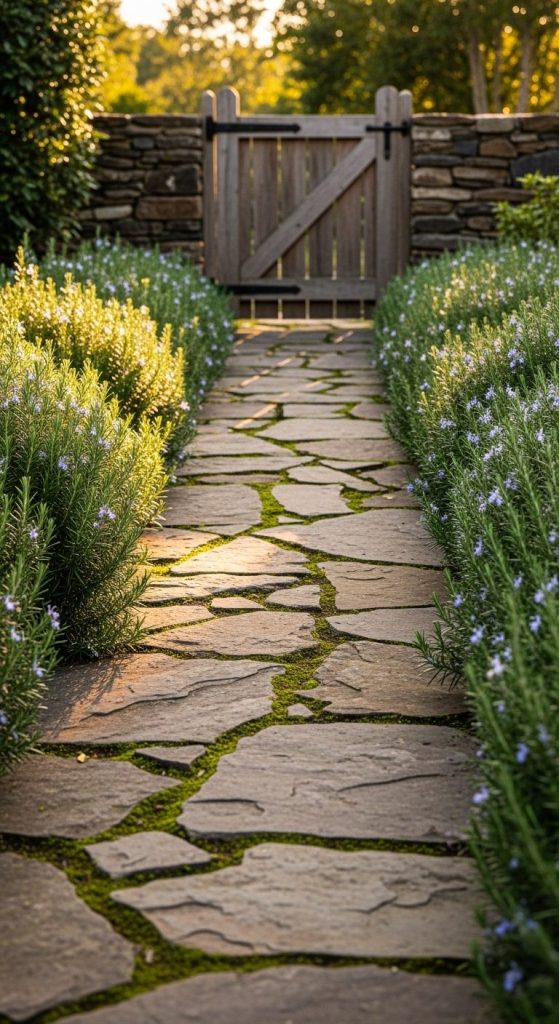
Think of your garden path — instead of plain edging, line it with low rosemary bushes. Every step, the aroma rises.
Pros:
- Creates a walking experience—your senses engage.
- Works well in Mediterranean or xeriscape style gardens — rosemary tolerates drought and rocky soils.
Cons:
- If the path is narrow and traffic heavy, rosemary might get damaged or need constant trimming.
- Needs good drainage—paths can collect runoff which rosemary dislikes.
Takeaway:
Upgrade your garden path from “just functional” to “sensory journey” by edging with rosemary.
10. Rosemary in Rock Gardens & Dry Slopes

If you’ve got a slope, rocks, or poor soil—no problem. Rosemary thrives in situations many other plants don’t.
Pros:
- Highly drought-tolerant and suited for rocky or lean soils.
- Adds texture and rustic charm to rock gardens—its silvery foliage contrasts beautifully with stones.
Cons:
- Some rock gardens are in full sun and get intense heat; rosemary handles heat but can suffer if roots overheat.
- If the slope drains too quickly and the plant doesn’t establish, you’ll need to mesh the roots better with soil amendments.
Takeaway:
Rocky corner or dry slope? Turn it into a design highlight with rosemary—functional and fetching.
11. Kitchen Herb Garden with Rosemary at the Heart

Let’s get edible. Plant a dedicated herb patch with rosemary as the anchor and build around it: thyme, oregano, basil (in part sun), etc.
Pros:
- Fresh herbs at hand for cooking. Rosemary is particularly long-lived and stays useful.
- Adds a dual role: decorative and edible — maximizing your garden’s value.
Cons:
- Herbs have different needs: while rosemary likes dryish conditions, basil loves more moisture—so you must zone the bed wisely.
- As an edible garden, you’ll need to harvest, maintain and possibly rotate plants.
Takeaway:
If you cook as you garden (and garden as you cook), let rosemary be your herb-garden MVP.
12. Rosemary for Wildlife & Pollinators

Yes, you can garden and help nature. Rosemary’s flowers attract bees and beneficial insects.
Pros:
- Supports pollinators — increasing biodiversity in your space.
- Adds another layer of value: you’re not just growing for yourself, you’re growing for wildlife.
Cons:
- Flowers may not be as showy or glamorous as big annual blooms—rosemary’s charm is nuanced.
- If you prune for shape, you might reduce flowering, which slightly diminishes the benefit to pollinators.
Takeaway:
Want your garden to be a mini-ecosystem? Plant rosemary and let the bees move in.
13. Mixing Rosemary with Coastal or Mediterranean Style Gardens
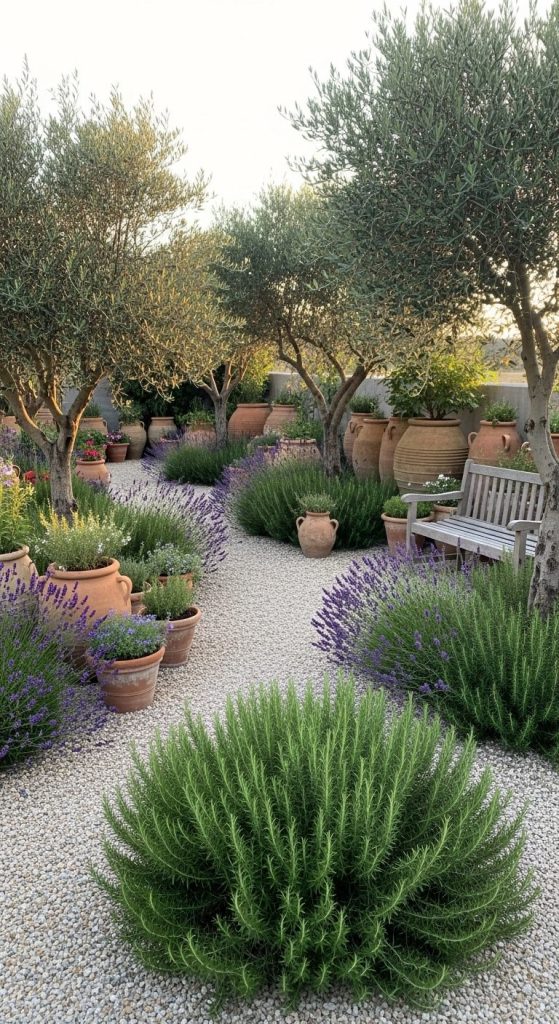
If your home or climate leans coastal, or you love that relaxed Mediterranean look, rosemary fits beautifully.
Pros:
- Its look (silvery foliage, woody stems) pairs with olive-trees, lavender, stonework and terracotta.
- Thrives in sun and dries—good for warmer or coastal zones with less garden maintenance.
Cons:
- If you’re in a humid, shady, or poorly-draining climate, you’ll need to tweak conditions to match rosemary’s preference.
- Might not feel “lush” in the tropical sense—this style leans more relaxed, structured, less rainforest-dense.
Takeaway:
Love that Mediterranean-villa-garden vibe? Rosemary is one of your essential players.
14. Seasonal Interest: Winter Texture & Early Blooms
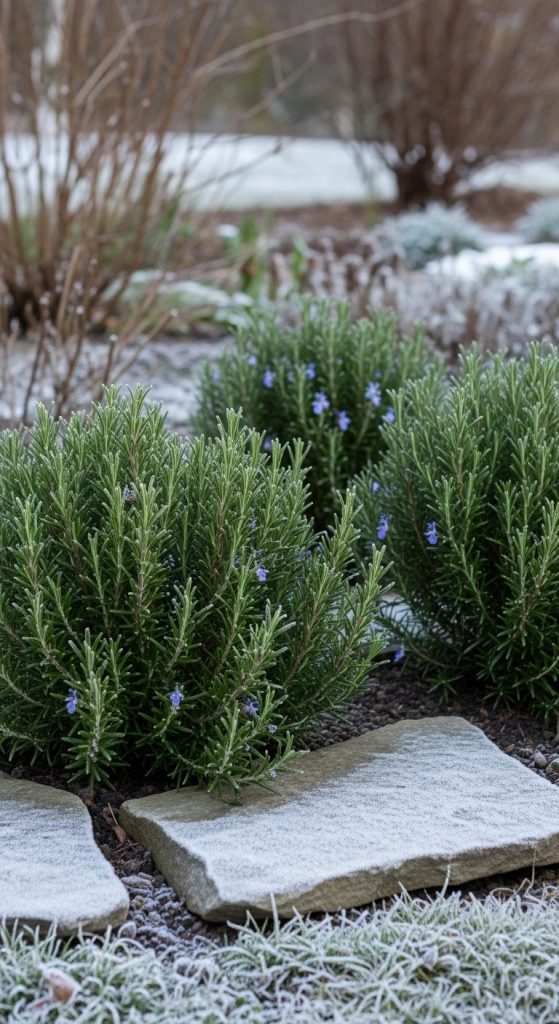
One of the hidden benefits: rosemary gives you green throughout the year, and often flowers early spring.
Pros:
- In winter or early spring when many plants are dormant, rosemary still offers foliage and even flowers.
- Great for adding year-round interest—not just “grow now and fade”.
Cons:
- If you live in a climate where rosemary isn’t fully hardy, you might need to protect it in colder months.
- If you prune at the wrong time (late autumn), you risk new growth that gets frost-damaged.
Takeaway:
Want your garden to stay alive and interesting even when most things have paused? Rosemary’s your evergreen ally.
15. DIY Projects with Rosemary: From Sculptures to Edible Gifts

Let’s wrap up with fun: think rosemary in DIY projects—wreaths, hedges in shapes, dried herb bundles for gifts, or small culinary plans by your kitchen door.
Pros:
- Makes gardening interactive and creative; rosemary’s fragrance adds extra oomph to any DIY.
- You get multiple “outputs”: garden beauty, home décor, edible or giftable extras.
Cons:
- If you over-harvest or trim for projects too often, the plant might suffer. Balanced care is still required.
- DIY-ing may require additional time and planning; it’s a “bonus” rather than a default.
Takeaway:
Turn your rosemary from “just a plant” into a lifestyle element—gift giving, craft moments, and garden-to-home links.
Conclusion
There you have it — 15 rosemary garden ideas that range from elegant hedges to playful DIY projects, from pest-smart companion planting to sensory pathway-liners. Each one shows just how layered this fantastic herb‐shrub can be in a garden context.
If I had to pick a favourite? I lean toward the “seating-zone surrounded by rosemary” scenario: I sit, I breathe in that aroma, I harvest a sprig, and my garden feels alive in a moment where I meant to pause anyway. It reminds me why I garden — for the small details, the textures, the scents, the tiny victories.
So pick an idea that speaks to your space, your style, and your rhythm. Plant the rosemary, tend it, cut it, breathe it in. And come back to it tomorrow and the next day and the next — because good gardens, like good friendships, grow gradually and reward patience. Here’s to your rosemary-rich landscape… may it smell amazing, look charming, and feel like you.

William Martin is a passionate bowler who spends most of his weekends playing the sport. With years of intense experience under his belt, William decided to share his knowledge by creating BOWLING OCEAN. Join me on this journey to explore the world of bowling and discover the tips and tricks to becoming a pro.

